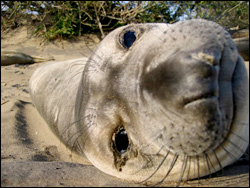
This educational website was produced with funding from National Science Foundation Grant IOS-0641801.
World class deep diver
The Elephant Seal

What's inside -
• Basics: elephant seal basics
• Lifestyle: hidden lives revealed
• Diving: going to extremes
• Oxygen: nature's engineering
• Conservation: the brink of extinction
• Human benefits: unexpected gifts
___________________________________
With content provided by Jessica Meir and Paul Ponganis.
Reviewed October 27, 2009 by Jessica Meir, Birgitte McDonald,
and Paul Ponganis.

Bull elephant seal - The northern elephant seal
Mirounga angustirostris.
at Piedras Blancas along the coast of central California. Adult males are called bulls.
Photographer - g-na. License granted according to Creative Commons Attribution-Noncommercial 2.0 Generic
It begins in November with the arrival of the serious contenders, the behemoth males that come from the sea.
They arrive early, to fight for beachfront property and attract large harems. Soon-to-be mothers arrive next and their pups a few days later.
In Januaries of recent years, more than 100,000 elephant seals appear on California beaches during the breeding season. Over the year, individuals come-and-go according to a complex schedule that masks how much of their lives they spend at sea, in places that were unknown even two decades ago.

Scripps graduate student
Jessica Meir. This website was produced with Jessica while she was a Ph.D. candidate at Scripps Institution of Oceanography at UCSD.
Photographer - Patrick Robinson.
• What's a graduate student?
Decline, recovery and future - Every northern elephant seal is a descendant of just 100 or so individuals that remained at the end of the 19th century after hunting had reduced their numbers.
In his account from 1874, whaler and naturalist Charles Scammon reported that a "fat bull, taken at Santa Barbara Island ... in 1852, was eighteen feet long, and yielded two hundred and ten gallons of oil" [27]. Elephant seals, and more significantly whales, were once valuable sources of oil for lamps and machines.
The last elephant seals were saved by the coincidence of their extreme scarcity, international conservation efforts and development of alternative fuels at the start of our fossil fuel-based economy.
They have been a conservation success story, but there are new concerns about their continued success. Climate change is expected to affect a part of the world we've just begun to explore - the deeper parts of the ocean where elephant seals spend most of their time hunting for food.
The fossil fuels that saved their blubber a century ago may be altering their food supply.
Extreme capabilities, extreme solutions - In the mid-1990s, satellite-based tracking tools became affordable enough to let biologists follow these animals.
Elephant seals turned out to be one of the world's deepest-diving and farthest migrating air-breathing mammals.
Some were diving nearly a mile under and staying down for as long as two hours.
 Weaner at Año Nuevo, California.
Photographer - Jessica Meir.
Weaner at Año Nuevo, California.
Photographer - Jessica Meir.They were spending most of their time hunting at unusual depths where human impacts on fish stocks and habitat were just beginning to be realized.
How these animals dive so deep is still a secret. Scientists don't know enough about these animals yet because the numbers don't add up. Elephant seals stay down longer than their known oxygen supply should allow.

Researchers Paul Ponganis and Jessica Meir want to know how they do it. Are these animals carrying more oxygen than we think? Do they have novel ways to stretch their oxygen supplies?
Jessica and Paul’s recent research has revealed that elephant seals can tolerate much lower levels of oxygen than humans. Humans lose consciousness with more than a quarter of their oxygen supply left, while elephant seals operate down to nearly zero. This capability is particularly interesting because it may translate into better ways to help people survive stroke, heart attack, and organ transplant surgery.
Research raises our awareness of the needs of these animals and informs efforts at conservation. Knowledge of the behavior and physiology of this animal is vital to understanding its role within complex ecosystems. Furthermore, this research has potential benefits to human health.
Continue and learn more about these animals.